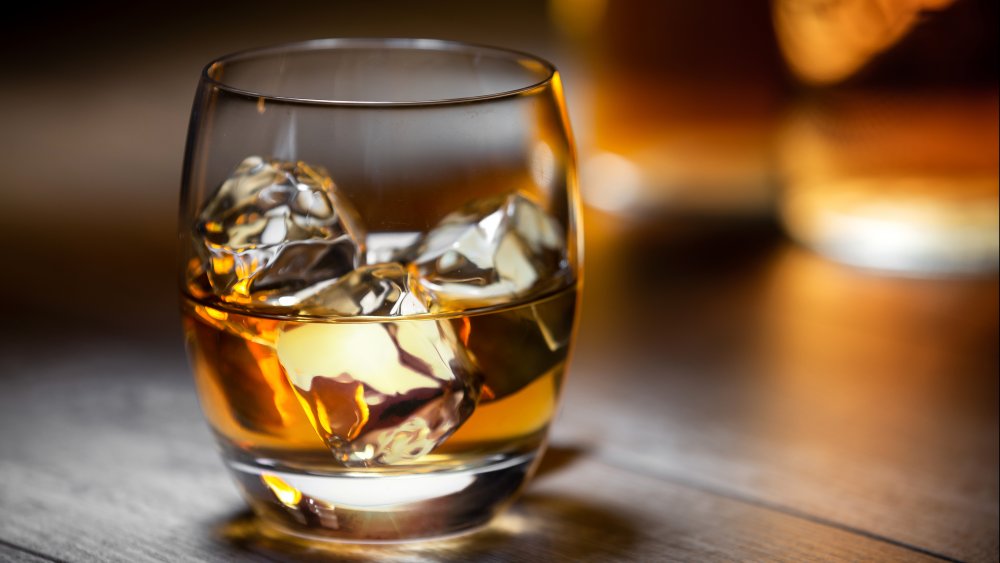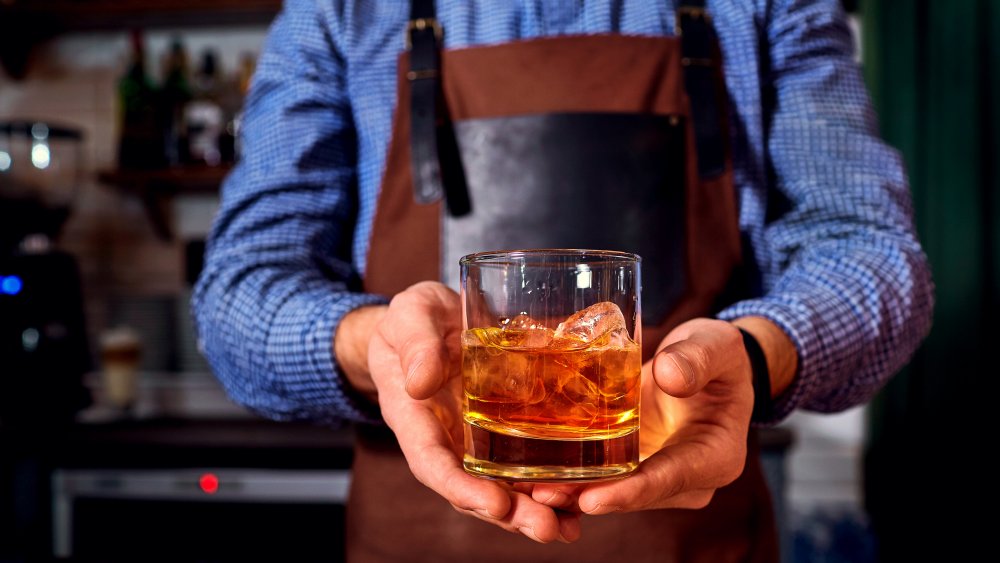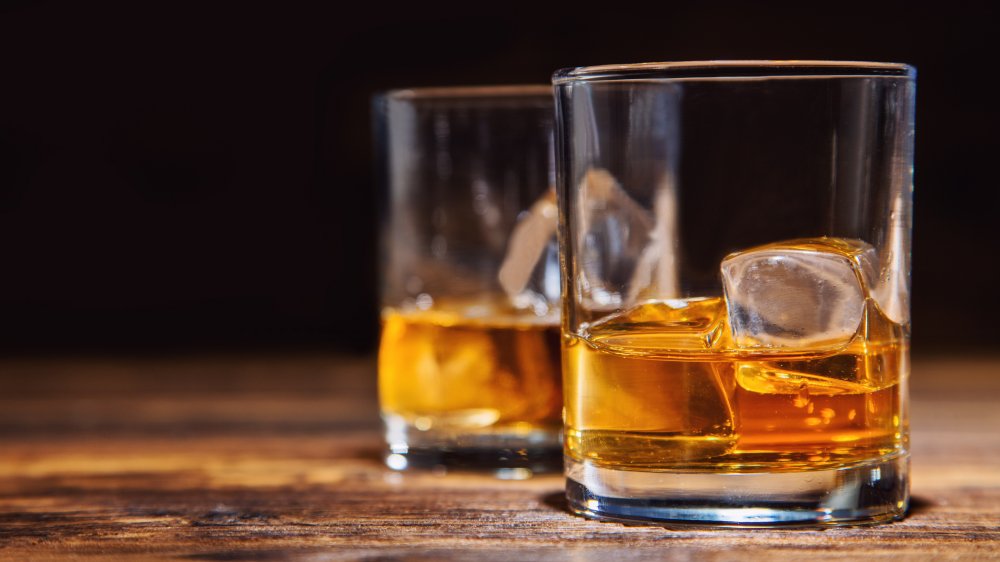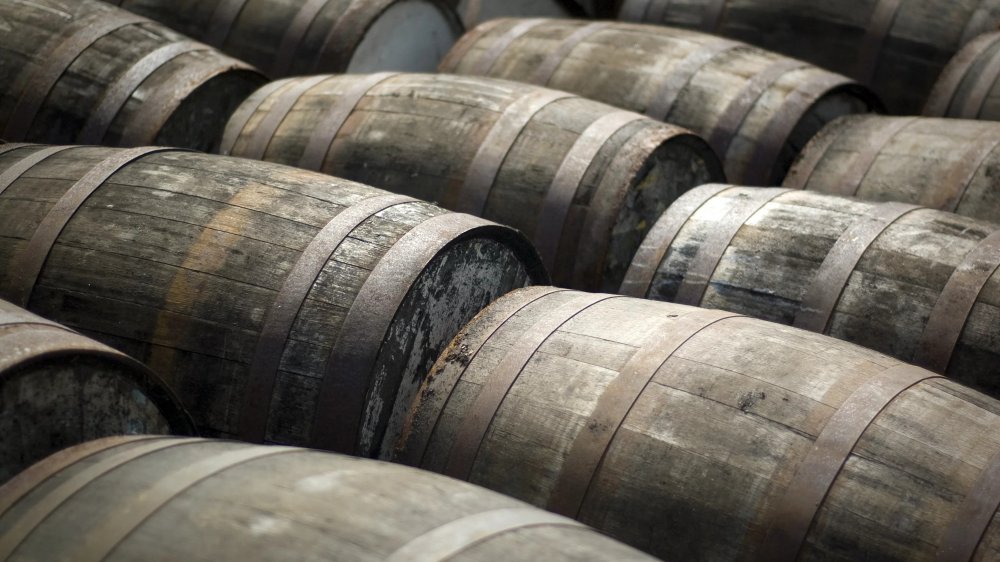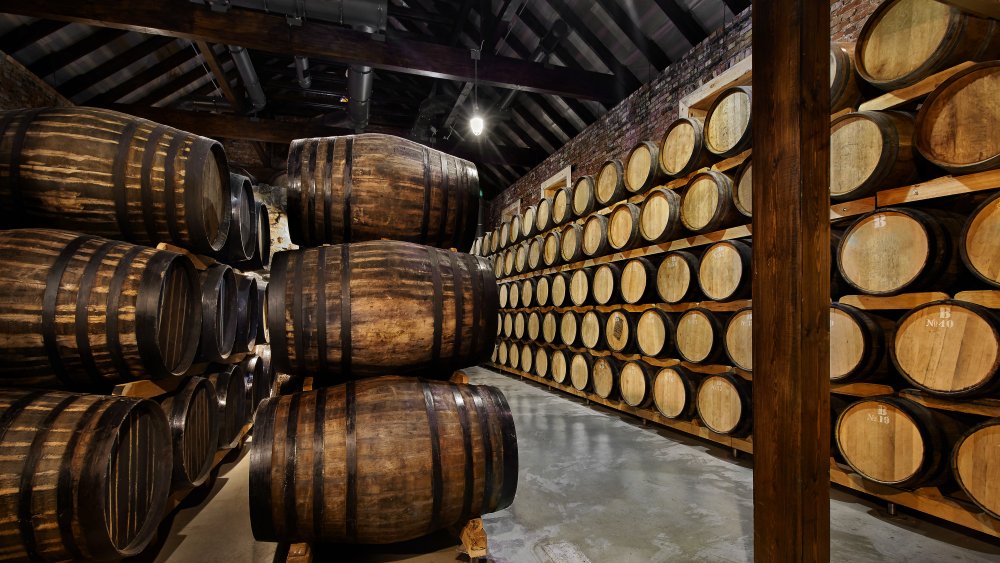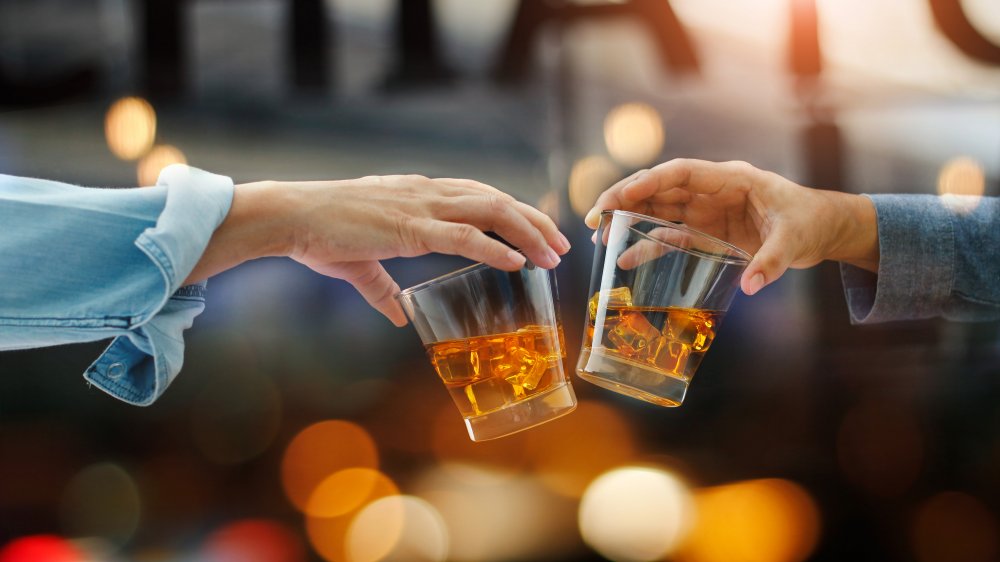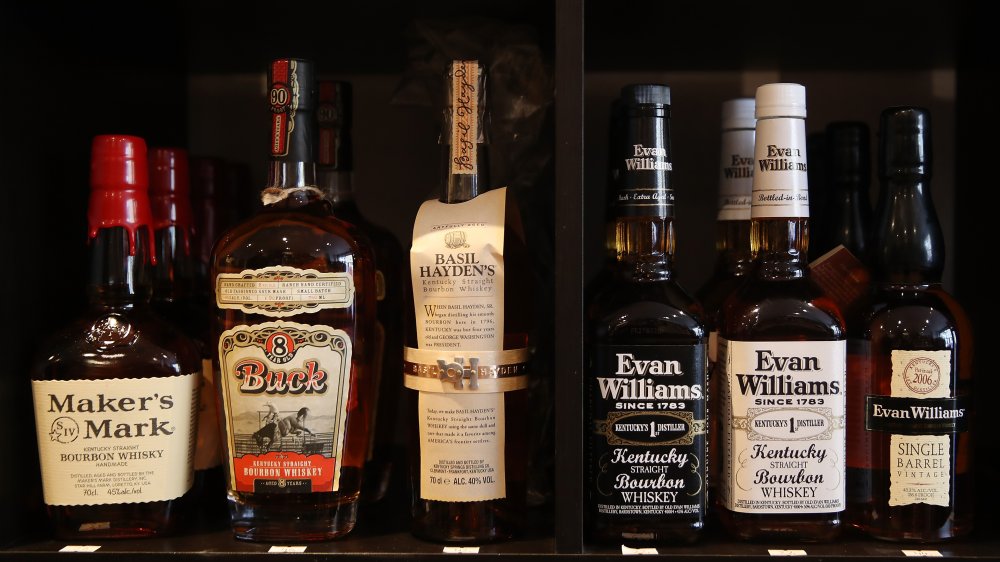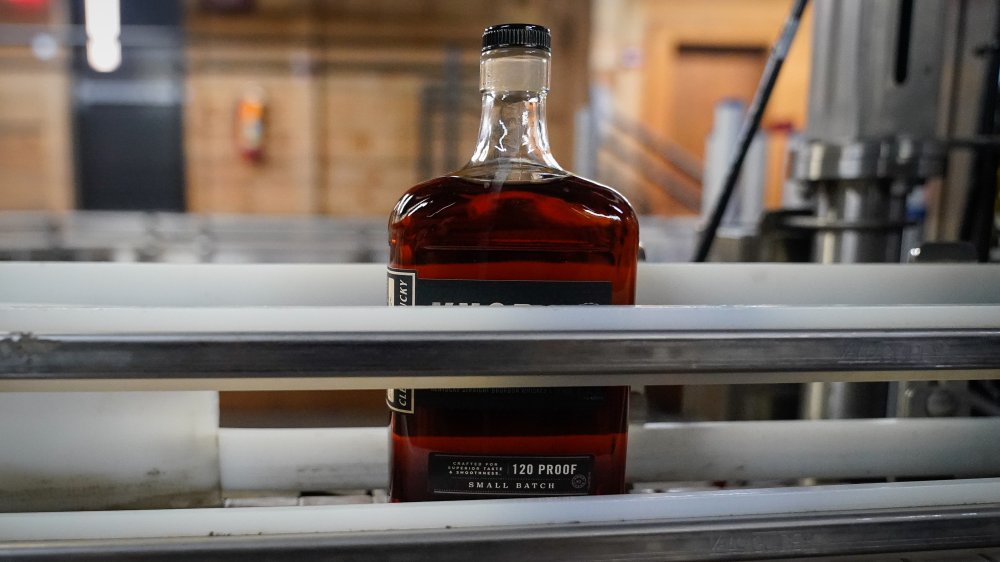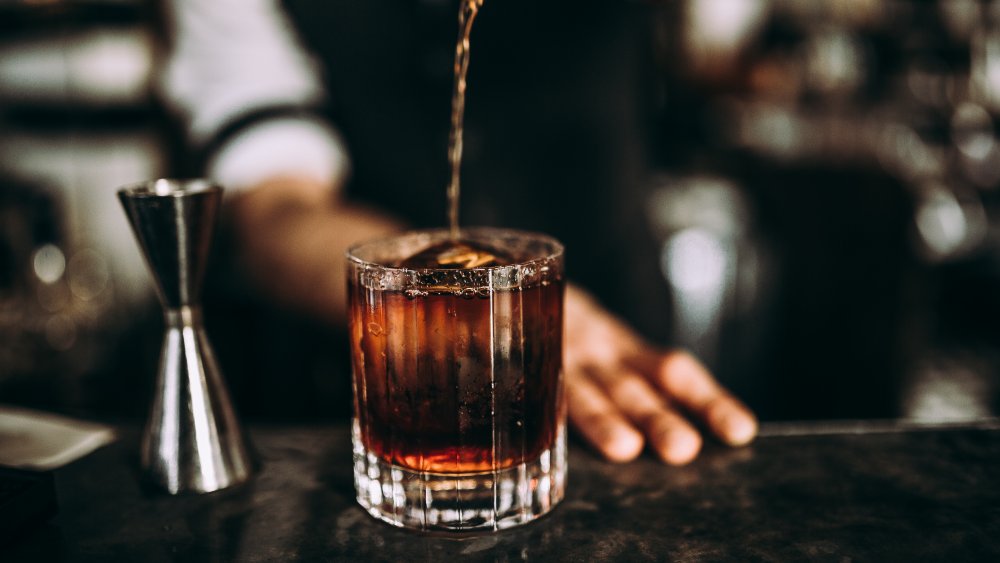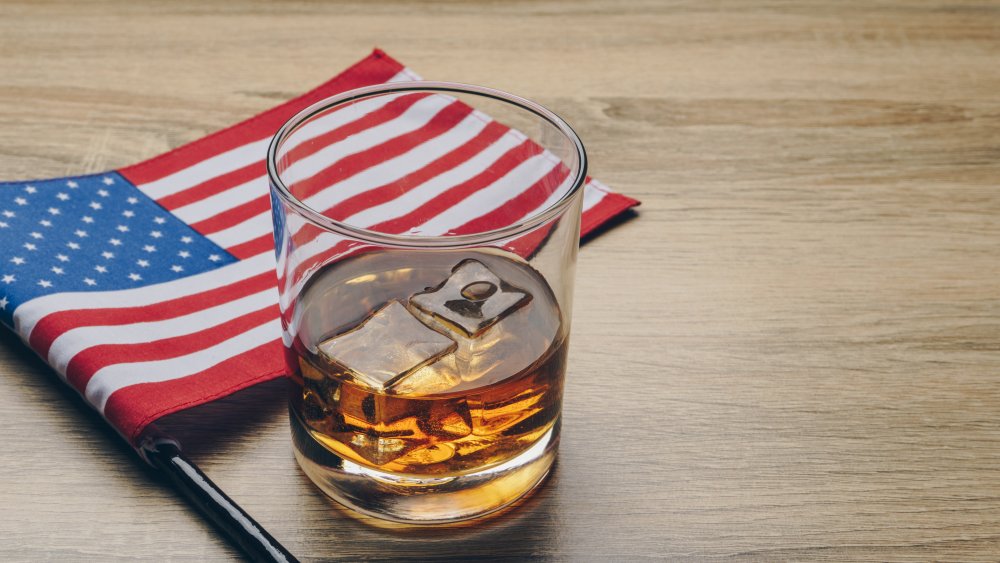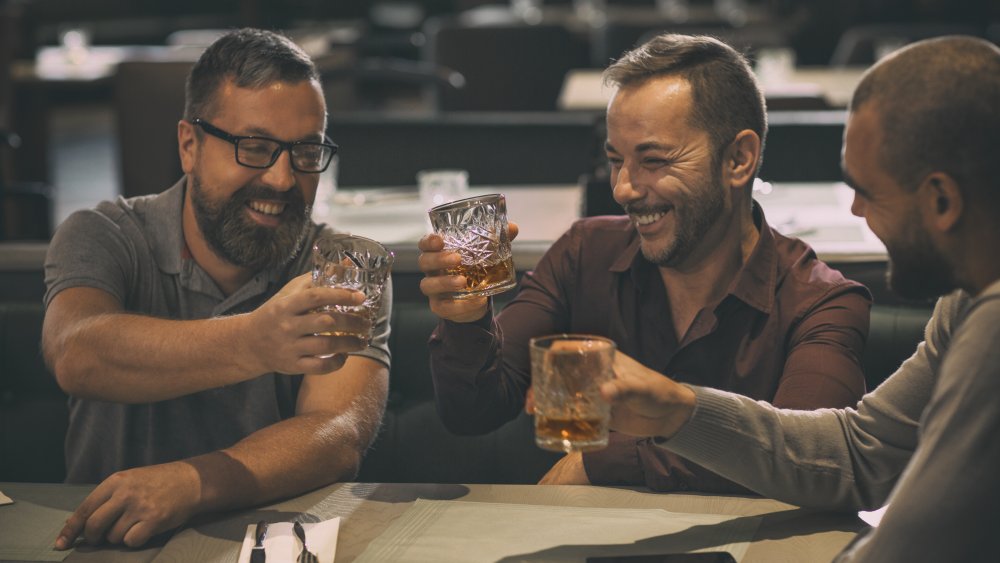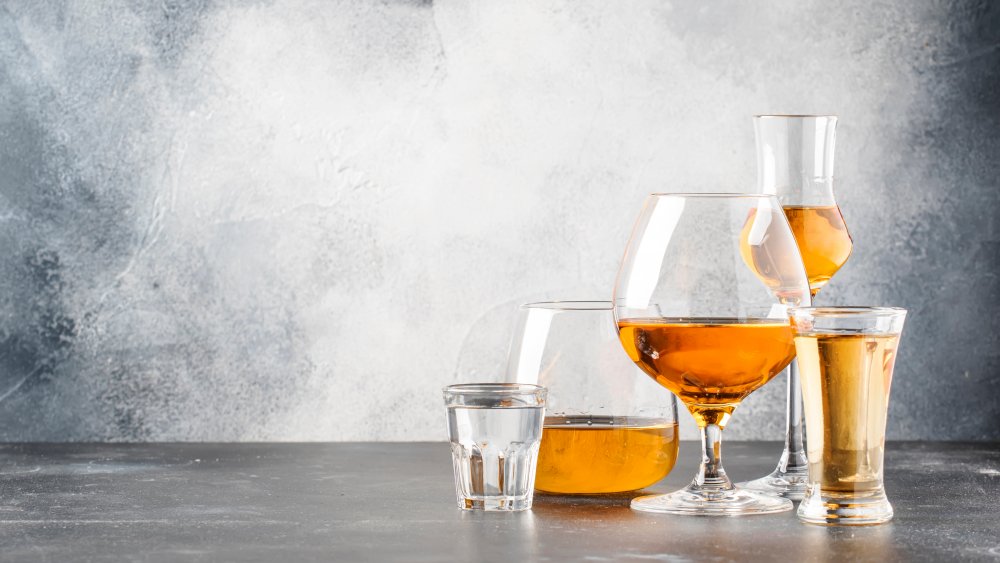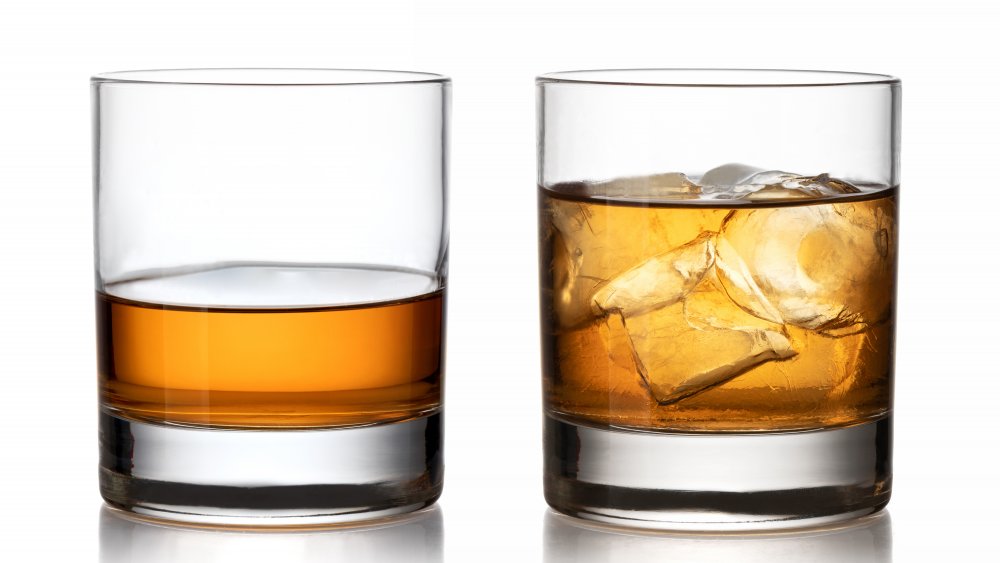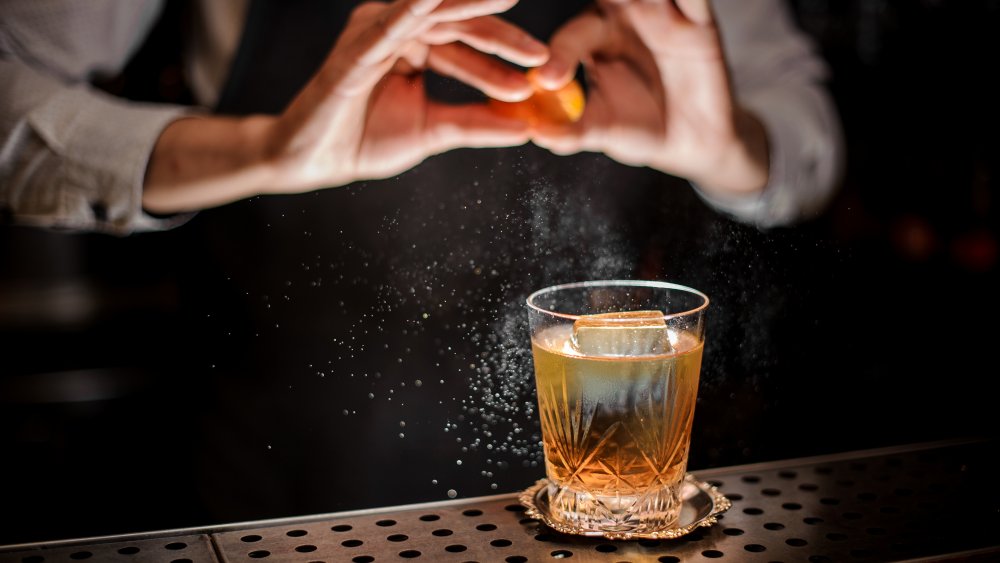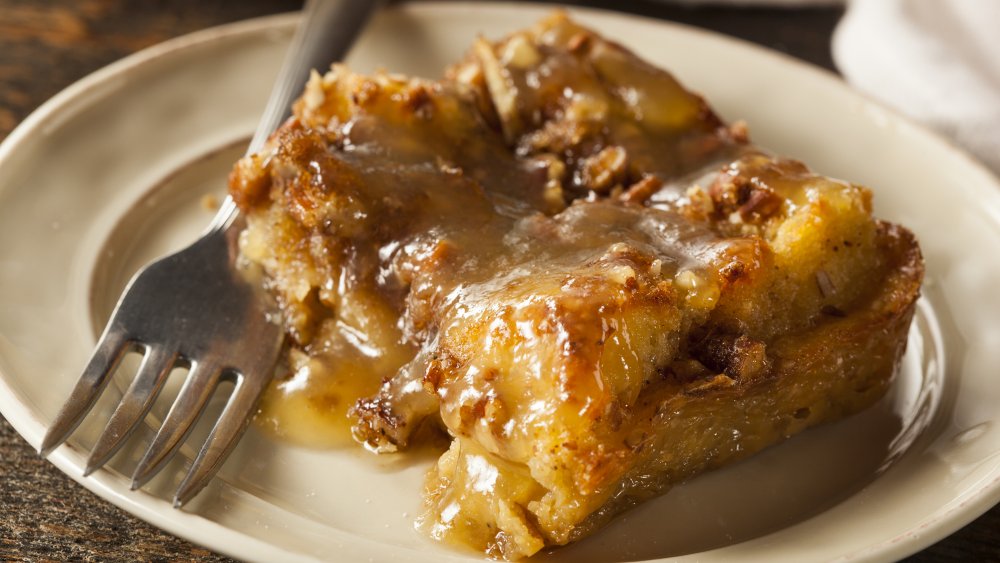What You Should Know Before Taking Another Sip Of Bourbon
Sitting down with a nice glass of bourbon may be the ideal way to finish out the day. Its buttery caramel and vanilla notes, along with its smooth mouthfeel, make bourbon the ideal sipping spirit. And with that, it allows drinkers to enjoy it in a multitude of ways.
Whether you're a bourbon aficionado, with your home bar stocked with plenty of bottle options, or you just enjoy cocktails that happen to have bourbon in them, this craft beverage really is a fascinating one. After all, there are a plethora of options on your store liquor shelves these days, from famed Kentucky bourbon to growing craft distilleries all across the U.S. from Washington to New York.
But is there more to bourbon that meets the eye? Absolutely. And we decided to dive in to learn more. From the way this craft spirit has to be made to actually be considered bourbon to the variety of ways you can enjoy it, this is everything you should know before taking another sip of bourbon.
Bourbon has been around since the 1700s
Although it may seem like bourbon has only been soaring in popularity recently, this spirit has actually been around a really long time. And with that age, it certainly has a bit of a storied past.
As settlers came to America from Scotland and Ireland in the late 1700s, they brought their knowledge of making whiskey with them. Noticing the abundance of corn, it made perfect sense to use this sweet, starchy crop to make grain alcohol, as it was previously being made with wheat and rye. And thanks to the large amounts of corn available at their fingertips, bourbon was relatively cheap to produce and sell and easily accessible for many.
The first commercial distillery in Kentucky was opened in 1783 by Evan Williams, a name we still recognize on shelves today, and the Beam family followed, selling their first barrel in 1795. Advertising for bourbon began in Kentucky in 1821, and the spirit has continued to flourish ever since.
It's not the same as whiskey
The important thing we have to get straight when it comes to bourbon, is that it's definitely not the same as whiskey. However, there are some similar qualities between the two. As the saying goes, all bourbon can be considered whiskey, but not all whiskey you find at the bar can be called bourbon. And that all has to do with definitions.
Whiskey comes in many forms. All whiskeys are made utilizing grain, but that may differ from region to recipe, incorporating everything from barley, rye, wheat, or corn. But the location of where the grain is fermented, the alcohol is distilled, and the whiskey is aged is what changes the name distinction. If it's from Scotland, it's considered Scotch, whereas the whiskey coming from Ireland is considered Irish Whiskey, and each of those spirits has its own specific requirements. If it's from America, you get to call it American whiskey, or the more common name, bourbon.
There are specific qualifications for a spirit to be called bourbon
One of the main considerations for a spirit to be called bourbon is the way corn is utilized, making up 51% of the mash bill. But there are other qualifications at play.
During the distillation process, bourbon has to be distilled to 160 proof or less, and when it's put into the barrel, it has to be documented at 125 proof or less. But it can't be put in any old barrel. The qualifications for bourbon state that the barrel being used for aging has to be a brand new, charred oak barrel. To char a barrel, a fire is started inside, and that is what offers up the vanilla and caramel notes, as the spirit liquid takes on the flavors and aromas of the barrel while it ages.
And last but not least, for whiskey to be called bourbon it has to be made on American soil, whether in Kentucky or another state.
Bourbon is made a very specific way
The process of making bourbon all starts out with corn as the base grain. For a bourbon to truly be considered bourbon, rather than a whiskey, it's required to have a mash bill of at least 51% corn, meaning some bourbons may incorporate small percentages of wheat or rye, but it's the corn majority that makes it king.
Corn and water are combined to create moisture in the starch, which kicks off a process called germination. Basically, starches from the corn are converted to sugars and extracted to be used in the fermentation process. Specific yeast strains are added, which eat the sugars and convert them into alcohol. Then, the distillation process is employed to remove any unwanted flavors or aromas, basically separating the liquid into two parts. The alcohol is boiled at a high temperature, and vapors rise off the liquid which then becomes the spirit.
Yes, there's good and bad bourbon out there
When it comes to buying liquor, there are always those who purchase options from the bottom shelf, typically to use with mixers, and there are those who splurge for a top-shelf option. And as with any spirit, there definitely are differences between those top and bottom-shelf options for bourbon.
Of course, bourbon should taste good first and foremost. And if you have a bottle of bourbon that you think tastes good, no matter the price point, then you might as well stick with it. Much of the flavor of bourbon comes from utilizing good water and corn, but the barrel imparts flavor to the finished product as well. Finding something that has a nice, balanced flavor is important.
The second key to choosing a good bourbon is all about how it feels as you're drinking it. A sip of bourbon should be smooth and heavy. The oak barrel adds a buttery characteristic to bourbon, and that should lend itself to a thickness in the spirit that makes for easy drinking. The last thing you want is for it to burn your throat as you're sipping (no good). A balanced, smooth sip will tell you it's good bourbon, made with care.
Kentucky produces more bourbon than anywhere else
Kentucky has been long known as the capital of bourbon in the United States. But that certainly wasn't just by happenstance.
Because the base of making bourbon starts with water, it ought to be good water. Just like any other recipe, starting with great ingredients will produce better results. As it turns out, the water in Kentucky is incredibly special, as Kentucky is sitting on deposits of blue limestone. The limestone acts as a filter for unwanted minerals such as hard iron, ultimately resulting in sweeter tasting water. The unique water, paired with the incredibly fertile ground for growing corn, makes it the ideal spot. And based on Kentucky's production numbers, it's pretty obvious the state's distillers have found their niche in bourbon.
According to the Kentucky Distillers' Association, Kentucky had 95 distilleries as of 2021, and those distilleries are working to craft 95 percent of the world's supply of bourbon. And with that production comes a lot of barrels — so many barrels that for every person who lives in Kentucky, there are almost two barrels.
Bourbon has very specific labeling requirements
At this point, it's pretty clear that there's a lot that goes into making legit bourbon. It's much more than just a drinkable spirit, and there are so many qualifications that make a craft beverage true bourbon. And those qualifications stem into the labeling process of bourbon bottles as well.
The phrase "straight bourbon" is often thrown around, and it has its own set of qualifications. Straight bourbon needs to follow the mash bill, proofing, and barrel requirements that regular bourbon does, but it also needs to hit a few other marks.
For a producer to put straight bourbon on a label, the spirit has to be aged for at least two years in the barrel, and things like caramel coloring, vanilla extract, or other additives can't be introduced whatsoever. In addition to labeling whether the bourbon is straight bourbon or not, the bottle is also required to tell you just how old that bourbon is. If a bourbon was in the barrel aging for more than two years — and four if labeled "bottled in bond" — the bottle must state that information.
It wasn't always named bourbon
Although bourbon certainly has deep roots in American history, it wasn't always known by that title. In fact, it wasn't officially dubbed bourbon until 1840.
As we mentioned, all bourbon is a form of whiskey, it just depends on how it's made that gives it the official distinction. And because the concept of bourbon stemmed from other whiskeys such as Scotch and Irish Whiskey, the craft beverage went by the name whiskey for a long time. Often, it was referred to Bourbon County Whiskey, because of the production happening in Bourbon County in upstate Kentucky.
According to Smithsonian Magazine, two French men began shipping bourbon from Louisville or New Orleans, and they knew those in Louisiana with French roots would love it because of its similarities to cognac. The spirit was historically sold on Bourbon Street in New Orleans, and according to historian Michael Veach, people would start asking for the whiskey that was sold on Bourbon Street. With those two references, whiskey was dropped from the name to give the spirit its own distinction.
Bourbon is the official American spirit
America dubbed the bald eagle as the national bird in 1787, so why not make an official American spirit, too? The U.S. eventually did, but the process certainly didn't come without debate.
Bourbon wasn't considered terribly fancy back in the day. After all, distilling was kind of a corrupt industry, as bootlegging occurred during prohibition. But when legislation to make bourbon a "distinctive product of the United States" was introduced in 1964, legislators put the values of the distilling industry aside and considered the main point at hand — bourbon certainly was wholly American.
With its qualifications to be considered bourbon, no other country can produce bourbon, or call its spirit bourbon, and America was proud of that, especially those in Kentucky working hard to produce it by the gallon. To celebrate that distinction, another bill was introduced in 2007 to establish September as National Bourbon Heritage Month, and throughout that process, the writing of the bill ended up calling bourbon "America's Native Spirit," celebrating a beverage that truly can only be made in the U.S. of A.
Americans drink a lot of bourbon
With bourbon being the ideal sipping spirit, not to mention the official spirit of America, it's not shocking that Americans are consuming a ton of this stuff. But just how big the bourbon industry is still might surprise you.
According to the Kentucky Distillers' Association, bourbon is an $8.94 billion industry in Kentucky, amounting to more than 20,000 jobs annually in that state alone. And thanks to those many people working in the industry, 1.7 million barrels of bourbon were filled in 2019. So with those numbers, you can imagine Kentucky, along with other states, are pumping out plenty of bourbon for Americans to drink.
And they're definitely enjoying it. According to the Distilled Spirits Council, bourbon sales spiked by 8.1% in 2017, making a leap from a $252 million industry to $3.4 billion. Those numbers cover bottles of bourbon from low to high price ranges, making the spirit accessible to anyone of age who wants to enjoy it.
Some glasses are better than others for bourbon
As it turns out, just grabbing a coffee mug and pouring in some bourbon isn't exactly the right way to drink it. Certainly, it could work in a pinch. But, there are certain glasses that have been deemed better for sipping your bourbon than others.
First of all, bourbon is indeed meant for sipping, whether you're enjoying it neat or pairing it with other ingredients in a cocktail. What it's not meant for is taking shots while out at the bar with friends. Really, that would just be a waste of good alcohol, and you might as well be shooting vodka.
Kansas City bar owner Beau Williams told Liquor that enjoying bourbon is all about creating an experience with the aroma of the spirit. It's important to select glassware that will allow you to utilize all of your senses, creating the full experience. A glass with a larger base, leading to a tapered top is typically best as it allows for the movement of air. The notes of the bourbon sit at the wide bottom of the glass, but as you swirl the bourbon in the glass, the aromas rise to the top. Taking in the notes of vanilla and caramel through smell will make the first sip that much better.
Ice plays a role in enjoying a glass of bourbon
We know, it probably seems like there are a whole lot of rules to drinking bourbon, but hear us out. It's worth it for the full experience.
The key to enjoying bourbon is to capture complex, bold flavors. But if you're adding little pieces of crushed ice to your spirits glass, chances are, it's going to become watery pretty quickly. The science here is simple. The smaller the ice, the faster it will melt because it doesn't have the mass to hold it together. And that's exactly why bigger ice is recommended for enjoying bourbon on the rocks.
Molds are available for large spherical ice cubes, offering a perfectly sized ice cube for your glass. Because there's so much surface area to the round cube, it keeps your bourbon cold, while slowly melting, avoiding adding extra water in the glass and diluting your experience. These types of ice cubes are often utilized in classic bourbon cocktails such as the Boulevardier as well, allowing you to enjoy the intentional flavors of the bourbon cocktail without any liquid watering it down.
Bourbon can be used for excellent cocktails too
While bourbon has certainly stood on its own served up neat for decades, there's a lot more you can do with this American spirit. Bourbon provides the ideal complex spirit for a delicious cocktail, and bartenders have been coming up with unique recipes to complement and enhance its qualities for years.
The Bourbon Old Fashioned may be the most popular cocktail on the bar utilizing bourbon, paired with Angostura bitters, sugar, and water with a garnish of an orange peel. It's been around since the early 1800s to showcase how delicious bourbon could truly be.
The Mint Julep is another popular bourbon cocktail, using the spirit that is made in Kentucky. It was made the official drink of the Kentucky Derby in 1938, but it's really not hard to see why. With bourbon, simple syrup, fresh mint, and a fully packed cup of crushed ice, a Mint Julep is a simple, yet incredibly refreshing, cocktail highlighting Kentucky-made ingredients – the perfect celebration drink for the derby.
Bourbon is ridiculously delicious in dessert recipes
If there's one thing that desserts pair well with, it's alcohol. But we're not talking just any type of grain alcohol. Sure, you could pair a pineapple upside-down cake with a splash of rum, but it's not likely you're going to include vodka or gin into the mix. Some alcohols just complement desserts better than others, especially a delicious dark bourbon.
Because bourbon takes on the characteristics of the barrel it ages in, it ends up with beautiful buttery caramel and vanilla notes, sometimes with a splash of spice. Those qualities make it ideal for pairing with desserts featuring, of course, vanilla, caramel, baking spice, and nuts. Fall desserts typically feature those flavors, including pumpkin, apple, and brown sugar desserts, making them the ideal candidate for a splash of bourbon.
Utilizing bourbon in a batter for a praline cake adds complexity to the dish, while adding it to a caramel sauce balances out the sweetness and makes it all the more interesting. And by adding it to your dessert, you're setting the stage for the perfect experience, allowing you to serve a sipper of bourbon with dessert as the perfect end to a meal. If there's a single dessert that truly owes its existence to bourbon, it has to be Kentucky bourbon balls.
